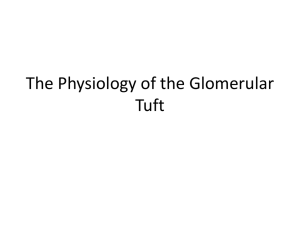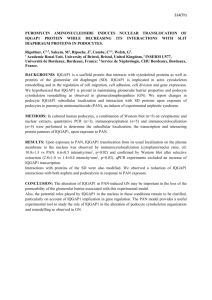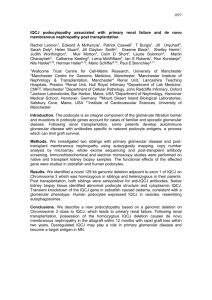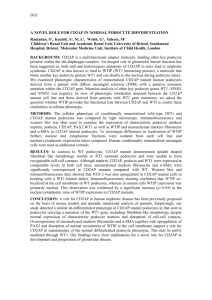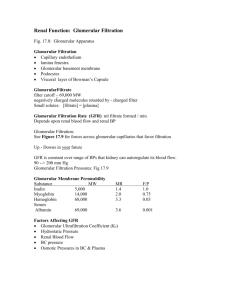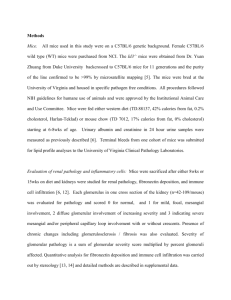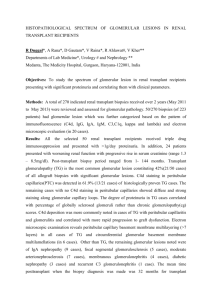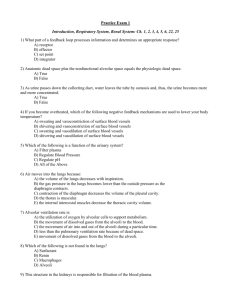histo- and ultrastructural aspects concerning renal corpuscle
advertisement
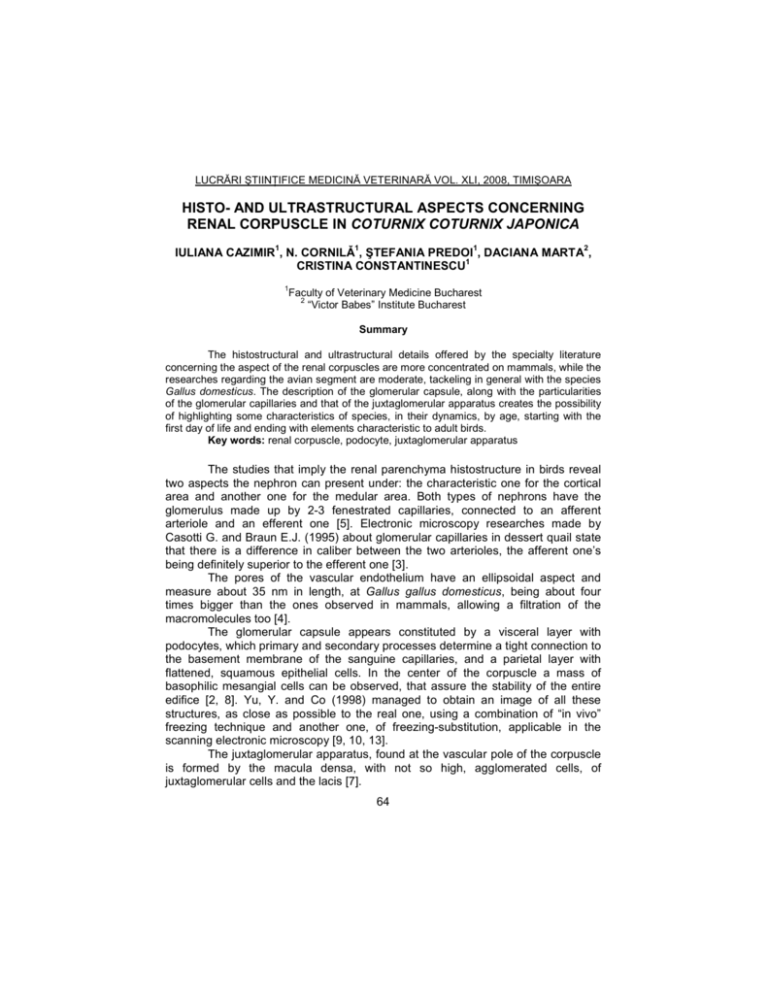
LUCRĂRI ŞTIINłIFICE MEDICINĂ VETERINARĂ VOL. XLI, 2008, TIMIŞOARA HISTO- AND ULTRASTRUCTURAL ASPECTS CONCERNING RENAL CORPUSCLE IN COTURNIX COTURNIX JAPONICA IULIANA CAZIMIR1, N. CORNILǍ1, ŞTEFANIA PREDOI1, DACIANA MARTA2, CRISTINA CONSTANTINESCU1 1 Faculty of Veterinary Medicine Bucharest 2 “Victor Babes” Institute Bucharest Summary The histostructural and ultrastructural details offered by the specialty literature concerning the aspect of the renal corpuscles are more concentrated on mammals, while the researches regarding the avian segment are moderate, tackeling in general with the species Gallus domesticus. The description of the glomerular capsule, along with the particularities of the glomerular capillaries and that of the juxtaglomerular apparatus creates the possibility of highlighting some characteristics of species, in their dynamics, by age, starting with the first day of life and ending with elements characteristic to adult birds. Key words: renal corpuscle, podocyte, juxtaglomerular apparatus The studies that imply the renal parenchyma histostructure in birds reveal two aspects the nephron can present under: the characteristic one for the cortical area and another one for the medular area. Both types of nephrons have the glomerulus made up by 2-3 fenestrated capillaries, connected to an afferent arteriole and an efferent one [5]. Electronic microscopy researches made by Casotti G. and Braun E.J. (1995) about glomerular capillaries in dessert quail state that there is a difference in caliber between the two arterioles, the afferent one’s being definitely superior to the efferent one [3]. The pores of the vascular endothelium have an ellipsoidal aspect and measure about 35 nm in length, at Gallus gallus domesticus, being about four times bigger than the ones observed in mammals, allowing a filtration of the macromolecules too [4]. The glomerular capsule appears constituted by a visceral layer with podocytes, which primary and secondary processes determine a tight connection to the basement membrane of the sanguine capillaries, and a parietal layer with flattened, squamous epithelial cells. In the center of the corpuscle a mass of basophilic mesangial cells can be observed, that assure the stability of the entire edifice [2, 8]. Yu, Y. and Co (1998) managed to obtain an image of all these structures, as close as possible to the real one, using a combination of “in vivo” freezing technique and another one, of freezing-substitution, applicable in the scanning electronic microscopy [9, 10, 13]. The juxtaglomerular apparatus, found at the vascular pole of the corpuscle is formed by the macula densa, with not so high, agglomerated cells, of juxtaglomerular cells and the lacis [7]. 64 LUCRĂRI ŞTIINłIFICE MEDICINĂ VETERINARĂ VOL. XLI, 2008, TIMIŞOARA Macula densa marks the origin of the distal convoluted tubule. In birds, Nicholson, J.K. and Co (1982), describe the electrono-concentrated aspect of the cytoplasm of the epithelial cells, which lack in microvili at the apical pole. In these cells, at the apical pole of the nucleus, the Golgi complex which is associated to the cisternae of the rough endoplasmic reticulum can be found [12]. Morild, I. and Co (1985) compared in his studies the aspect of the juxtaglomerular apparatus in the cortical and medullar nephrons, observing little differences. Therefore, in the corpuscle of the medullar nephron, that resembles the mammal nephron, the mesangial cells of the lacis, placed between the arterioles, glomerulus and macula densa, are more agglomerated and more numerous than in the reptilian cortical nephron. Occasionally, in the vicinity of the afferent arteriole of the corpuscle of the medullar nephron granulated epithelioid cells can be seen. As well, the afferent arteriole crosses the center of the dense cellular mesangial mass, unlike the case of the reptilian type corpuscle, where the arrangement is imprecise. The tight connection between the afferent arteriole and the lacis, assigned by a large surface, suggests the possible implication of the mesangial cells in the glomerular filtration regulation [6, 11]. All these data offered by the specialty literature include too little information about Coturnix coturnix japonica species, that in the last years, enjoyed from special interest of the breeders that used it for meat and eggs, but also for medicinal, ornamental, experimental purposes, sport, as a laboratory bird and environmental sensor, finding itself in the “test species” category, accepted by the “Organization for Economic Co-operation and Development (OECD)”, near the European Commission and in the “OECD Guide for chemical products testing” [1]. Obtaining and presenting some detailed histo- and ultrastructural elements present in the urinary apparatus come to complete the limited bibliographical area. These investigations demonstrate the opportunity to eliminate the risk of confusions and errors, offered by a morphological support as near as possible to reality, in order to distinguish the functional meaning in assuring the homeostasy of the organism. Materials and methods For the histostructural study there have been used 10 birds, belonging to Galliformes order, Phasianidae family, Coturnix genus, Coturnix japonica species, males, aged between one and ten weeks old. The prelevated pieces have been histologically prepared, seriated longitudinal or cross sections being made. In order to color the sections made, Haematoxylin and Eosin technique was used. The examination of the histological permanent sections were made with the NIKON-LABPHOT2 optical microscope, a light filter BG-33, Nikon AFX-DX and a NIKON FX-35 DX photo camera, and the images have been processed on the computer using Adobe Photoshop 6.0 software. 65 LUCRĂRI ŞTIINłIFICE MEDICINĂ VETERINARĂ VOL. XLI, 2008, TIMIŞOARA The biological material destined to the ultrastructural study, using TEM (Transmission Electron Microscopy) technique, was taken from two males, belonging to the same species, 70 days age old, and needed a laborious preparation that requires more stages, represented by: fixation, washing, dehydration, including in epoxide material, sectioning, contrasting, microscope examination and photography. Even if the succession of these stages is resembling to the one used in the optic microscopy, the reactives used and the complexity of each stage creates the specificity of the method. It is worth mentioning that the first sectioning stage of the blocks is made with an ultratom, with a 1µm thickness. The sections will be later on stained with Toluidine blue. The semifine sections are examined with the optic microscope and are chosen by photography of the areas of interest. Then, then semifine sections are cut using the ultramicrotome, at a thickness ranging between 60 and 80 nm. The technique of seriated sections allows the three-dimensional reconstruction of the structure of the tissues. For visualization and photographiation of the images TEM Philips M301, 40-100kV microscope was used, with a resolution of, which allows a magnification of 54 000 times. Results and discussions Structurally, in the renal parenchyma are evident the medullary corpuscles, which have a diameter ranging between 21.92µm and 27.46 µm at the one day age old; 23.17µm and 28.44 µm at the 7 days age old; 46.44µm and 51.72µm at the 70 days age old and cortex corpuscles, which have a diameter ranging between 32.38µm at the one day age old, 33.04µm at the 7 days age old and 53.86µm at the 70 days age old (Figure 1). Fig.1. Histostructural aspect concerning kidney parenchyma in the cortex region, at the japanese quail in 7 days old/ HE, ob.10x (authentic) 1. Proximal convoluted tubule; 2. Distal convoluted tubule; 3. Collecting tubule; 4. Thick segment, Henle’s loop; 5. Glomerulus; 6.Intralobular vein. 66 LUCRĂRI ŞTIINłIFICE MEDICINĂ VETERINARĂ VOL. XLI, 2008, TIMIŞOARA The capsule of the renal corpuscle appears to be constituted by a parietal layer and the second, the visceral layer with podocytes. The epithelial cells of the parietal layer are flattened and have elongated nuclei. They linning the hole corpuscular teritory and limit, with the external surface of the podocytes of the visceral layer, the capsular space. In the center of the corpuscle an agglomeration of basofil mesangial cells, surrounded by many fenestrated capillaries (Figure 2). Fig. 2. General view concerning renal corpuscle, at the japanese quail in 70 days old/ Toluidine blue, ob.40x (authentic) 1. Squamous cell, parietal layer of Bowman’s capsule; 2. Podocytes; 3.Mesangial cells; 4. Glomerular capillaries; 5. Endothelial cell. The electronic microscopy images highlight best the relations between the podocytes and the capillary wall. Primary podocytes processes that surround the capillary wall can be observed. From this level, secondary podocytes processes are very numerous, thin and short, perpendicularly attached to the basement membrane of the capillary. At origin they have a conic aspect, which gradually becomes thinner. The distal end is wider, in order to enlarge the area of contact with the basement membrane. In the cytoplasm of the two extremities of the secondary podocytes processes, especially at the origin, a series of phagosomes and pynosomes can be distinguished, along with an electrono-concentrated, granular material (Figure 3, 4). The nucleus of the podocytes is oval, euchromatic and has obvious nucleoles. Sometimes is a little deformed, generating the appearance of a reduced identitation. The presence of processes of different sizes creates the flattened aspect of the cell, that has only one proeminent single central area, the one occupied by the nucleus. 67 LUCRĂRI ŞTIINłIFICE MEDICINĂ VETERINARĂ VOL. XLI, 2008, TIMIŞOARA Fig. 3. Renal glomerulus histostructure, at the japanese quail in 70 days old/ TEM, 14 200x (authentic) 1. Podocytes; 2. Capillaries; 3.Nucleus; 4. Podocytes processes; 5. Basement membrane; 6.Fenestrations. Figure 4. Structural relation establish between podocyte and capillary, at the japanese quail in 70 days old/ TEM, 22 000x (authentic) 1. Podocyte; 2. Capillary; 3.Nucleus; 4.Primary podocytes processes; 5.Secondary podocytes processes; 6.Basement membrane;7.Fenestrations; 8.Phagosome; 9.Rough endoplasmic reticulum; 10.Filaments; 11. Filtration slits. In the cytoplasm there can be seen polyribosomes, a perinuclear Golgi 68 LUCRĂRI ŞTIINłIFICE MEDICINĂ VETERINARĂ VOL. XLI, 2008, TIMIŞOARA apparatus, fragments of the rough endoplasmic reticulum, primary and secondary lysosomes and rare mitochondria. Near the plasmalema many pynocitosis vesicles are formed and in the cytoplasm of the processes, especially, there are many fine filaments (Figure 5). Fig. 5. Podocyte’s ultrastructure, at the japanese quail in 70 days old/ TEM, 18 200x (authentic) 1. Podocyte; 2. Capillary; 3.Identated nucleus; 4.Nucleoles; 5.Identation; 6.Podocytes processes; 7.Basement membrane; 8.Rough endoplasmic reticulum; 9.Golgi apparatus; 10.Mitochondria; 11.Lysosome. The juxtaglomerular complex can be highlighted at the vascular pole of the renal corpuscle, the differences between the afferent arteriole, the origin of the distal convoluted tubule and the extraglomerular mesangial cells being easy to observe. In the thickened wall of the afferent arteriole the dilated, oval, elongated nuclei of the juxtaglomerular cells can be noticed, that occupy only a very reduced surface. On the other hand, the extraglomerular mesangial cells of the lacis extent, following the line of the distal convoluted tubule, in the structure of which the cells of macula densa do not appear very well differentiated. All these considerations, together with the discreet separation of the components create a not so ordered arrangement, compared to the typical one, from mammals (Figure 6, 7). 69 LUCRĂRI ŞTIINłIFICE MEDICINĂ VETERINARĂ VOL. XLI, 2008, TIMIŞOARA Fig. 6. Afferent arteriole positioning near the renal corpuscle, at the japanese quail in 70 days old/ Toluidine blue, ob.40x (authentic) 1. Squamous cell, parietal layer of Bowman’s capsule; 2. Podocytes; 3.Mesangial cells; 4.Capsular space; 5. Glomerular capillaries; 6. Afferent arteriole; 7. Endothelial cell. Fig. 7. Detail concerning the juxtglomerular apparatus structure, at the japanese quail in 70 days old/ Toluidine blue, ob.40x (authentic) 1. Squamous cell, parietal layer of Bowman’s capsule; 2. Podocytes; 3.Mesangial cells; 4.Capsular space; 5. Glomerular capillaries; 6.Endothelial cell; 7. Macula densa; 8. Afferent arteriole; 9.Proximal convoluted tubule. At birds of one day age old, the elements of juxtaglomerular complex are hard to identify. From the capilarization of the afferent arteriole results a compact vascular agglomeration, in which the mesangial cells are rare. As well, the capillaries that make up the renal glomerulus have a very narrow lumen. The podocytes of the visceral layer of the glomerular capsule appear very close and 70 LUCRĂRI ŞTIINłIFICE MEDICINĂ VETERINARĂ VOL. XLI, 2008, TIMIŞOARA delimit a large capsular space, together with the flattened cells of the parietal layer (Figure 8). Fig. 8. Renal corpuscle histostructure, at the japanese quail in 1 day old/ HE, ob.90x (authentic) 1. Squamous cell, parietal layer of Bowman’s capsule; 2. Podocytes; 3.Mesangial cells; 4.Capsular space; 5.Proximal convoluted tubule. Conclusions In the first week of life, the growth of the average diameter of the renal corpuscles is insignificantly meaning a growth with only 4.54% in the case of the medullary type corpuscles and with 2.04% in the case of the cortex ones. In adults birds, the average diameter of the renal corpuscles tends to double itself, compared with the average of the values met in the first week of life, the growth for the medullary type corpuscles being with 93.38% and for the cortex ones with only 64.66%. The dimensional differences between the cortex and medullary type corpuscles at the age of one day are significant, difference valued at 31.15% favouring the cortex ones, while at adult birds there is a moderate difference of diameters, of only 9.74% favourig, as well, the cortex corpuscles. Ultrastructurally, in the cytoplasm of the periphery of the secondary podocytes processes, phagosomes and pynosomes can be observed, along with granular, electrono-concentrated material. Near the podocytes plasmalema, the electronic transmission microscopy images have revealed the forming of numerous pynocitosis vesicles, and in the cytoplasm of the processes, the presence of fine microfilaments. The element of the juxtaglomerular complex are hard to identify at birds of one day age old, and in birds of 70 days age old, it presents a less ordered arrangement compared to the one presented at mammals. 71 LUCRĂRI ŞTIINłIFICE MEDICINĂ VETERINARĂ VOL. XLI, 2008, TIMIŞOARA References 1. Banfi, M. - Impactul ecotoxicologic al unor pesticide destinate tratării seminŃelor, asupra avifaunei (cazul prepeliŃei japoneze-pasăre test conform normelor OECD). Teză de doctorat, USAMV, Timişoara, 2002. 2. Beuchat, C.A., Preest, M.R., Braun, E.J.- Glomerular and medullary , architecture in the kidney of Anna s Hummingbird. Journal of Morphology. 240, 95-100, 1999. 3. Casotti, G., Braun, E.J.- Structure of the glomerular capillaires of the domestic chicken and desert quail. Journal of Morphology. 224(1): 57-63, 1995. 4. CASOTTI, G., BRAUN, E.J.- Functional morphology of the glomerular filtration barrier of Gallus gallus. Journal of Morphology. 228(3): 327-334, 1996 . 5. Casotti, G., Lindberg, K.K., Braun, E.J.- Functional morphology of the avian medullar cone. Am. J. Physiol.Regul. Integr. Comp. Physiol. 279, 1722-1730, 2000. 6. Christiansen, K.J., Morild, I., Mikeler, E., Bohle, A.- Juxtaglomerular apparatus in the domestic fowl (Gallus domesticus). Kidney Int. 22, Suppl. 12, 24-29, 1982. 7. Cornilă, N.- Morfologia microscopică a animalelor domestice (cu elemente de embriologie),Vol.II. Ed. ALL, Bucureşti, 2001. 8. Kriz, W., Hackenthal, E., Nobiling, R., Sakai, T., Elger, M.- A role for podocytes to counteract capillary wall distension. Kidney International. 45, 369376, 1994. 9. Ohno, S., Hora, K., Furukawa, T., Oguchi, H.-Ultrastructural study of the glomerular slit diaphragm in fresh unfixed kidneys by a quick-freezing method. Virchows Archiv. B Cell Pathology. 61, 351-358, 1992. 10. Ohno, S., Terada, N., Fujii, Y., Ueda, H., Takayama, I.- Dinamic structure of glomerular capillary loop as revealed by an in vivo cryotechnique. Virchows Archiv. 427, 519-527, 1996. 11. Morild, I., Mowinckel, R., Bohle, A., Christensen, J.A.- The juxtaglomerular apparatus in the avian kidney. Cell and Tissue Research, Vol. 240(1):209-214, 1985. 12. Nicholson, J.K.- The microanatomy of the distal tubules, collecting tubules and collecting ducts of the starling kidney. Journal of Anatomy. 134(1), 11-23, 1982. 13. Yu, Y., Leng, C.G., Terada, N., Ohno, S.- Scanning electron microscopic study of the renal glomerulus by an in vivo cryotechnique combined with freeze-substitution. J. Anat. 192(4): 595-603, 1998. 14. *** Nomina Anatomica Veterinaria (Fourth Edition) together with Nomina Histologica (Revised Second Edition) and Nomina Embryologica Veterinaria. Zurich and Ithaca, New York, 1994. 72
